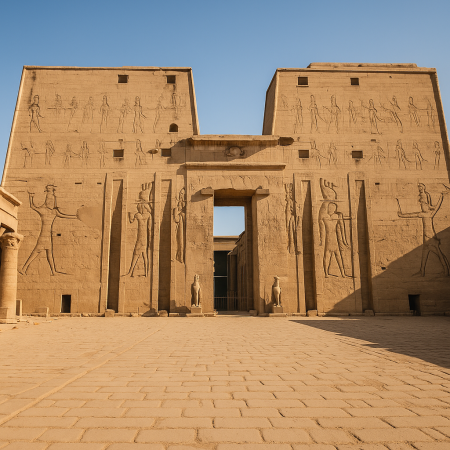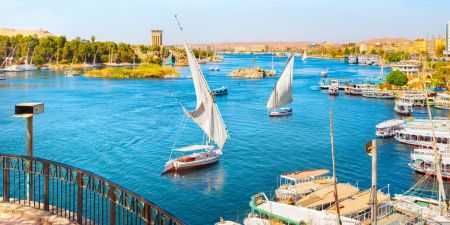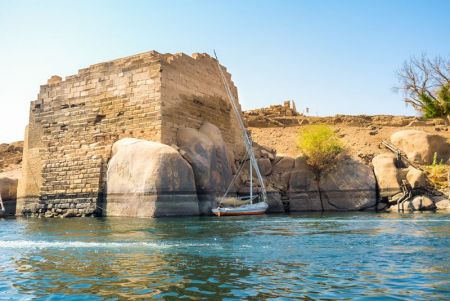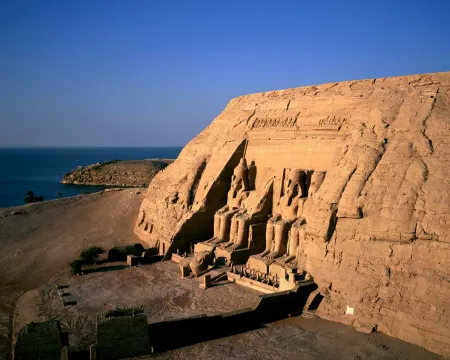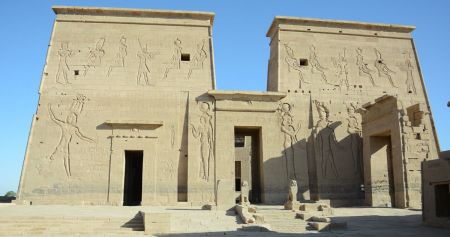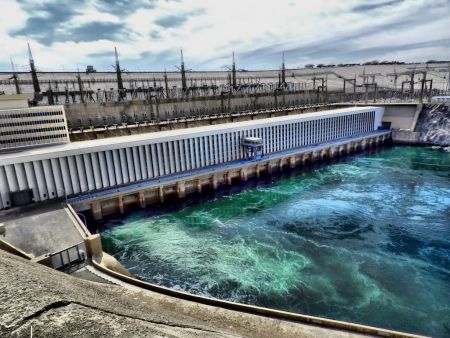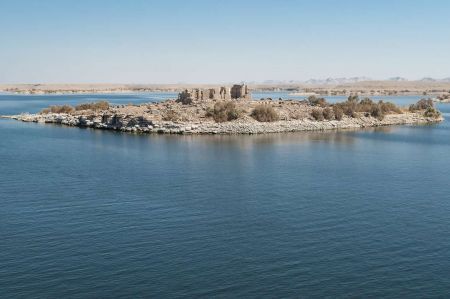Temple of Khnum: The Sacred Sanctuary of the Nile’s Creator God
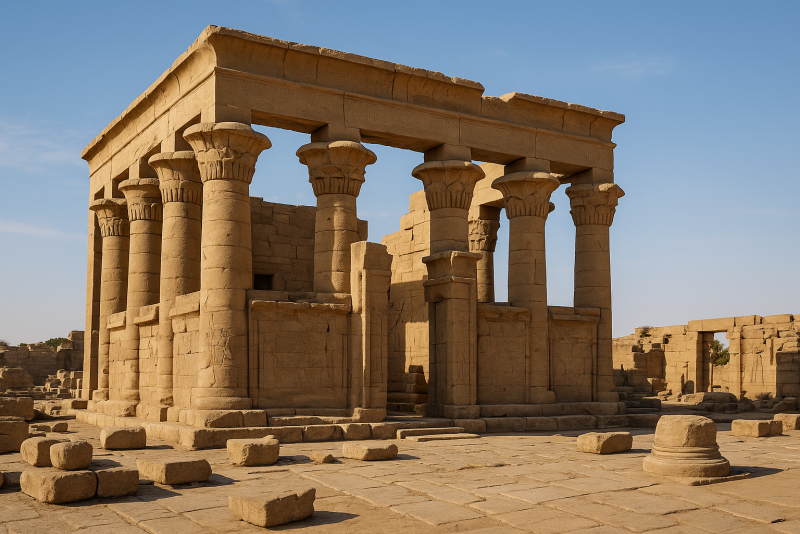
Resting on the historic Elephantine Island in the Nile at Aswan, the Temple of Khnum is a timeless tribute to one of ancient Egypt’s oldest and most revered deities. Khnum, the ram-headed god, was believed to control the source of the Nile and to shape human beings from clay on his divine potter’s wheel. This connection to creation, fertility, and the life-giving waters made the Temple of Khnum not just a religious center but the spiritual heart of the region. Its location at Egypt’s southern border also gave it political significance, marking the frontier between Egypt and Nubia and overseeing the gateway of goods, people, and ideas flowing along the Nile.
From the Middle Kingdom through the Ptolemaic and Roman eras, the temple evolved, expanded, and adapted to the needs of rulers and worshippers. Today, though much of the original structure is in ruins or reconstructed, the temple’s hypostyle hall, reliefs, and sacred spaces still exude the power and artistry of ancient craftsmanship. Standing here, you feel the rhythm of centuries—the measured rise of the Nile, the annual festivals, the steady devotion to Khnum as a guardian of creation and prosperity.
For modern visitors, the Temple of Khnum offers a unique experience that blends archaeology, mythology, and living culture. It is surrounded by Nubian villages rich in tradition and color, and its close proximity to other treasures on Elephantine Island makes it an essential stop in any Aswan itinerary. This is not merely a monument—it’s a living chapter of Egypt’s relationship with its river and its gods.
The Historical Importance of the Temple of Khnum
Khnum – The Potter God of the Nile’s Source
Khnum is one of Egypt’s most ancient deities, his worship stretching back into pre-dynastic times. Depicted with a ram’s head and a muscular human body, he was believed to dwell at the source of the Nile, controlling its flow and ensuring its annual inundation. According to myth, Khnum used a potter’s wheel to shape both humans and their destinies, fashioning them from the clay of the Nile and breathing life into their forms. This creative power made him a vital figure in Egyptian religion, particularly in Upper Egypt where the river’s flow began.
Religious Role of the Temple
The Temple of Khnum served as the focal point for ceremonies designed to honor the god and secure his favor. Priests performed daily rituals in the sanctuary, offering food, incense, and hymns to encourage a plentiful flood. Without the Nile’s seasonal rise, Egypt’s agriculture would fail—so Khnum’s blessings were not just spiritual but essential to survival.
Political and Strategic Significance
Elephantine Island was a border post between Egypt and Nubia, and the temple stood within a fortified town that controlled trade and military movements. Pharaohs recognized that maintaining Khnum’s cult reinforced their divine authority and their control over the region. Even during foreign rule, the temple retained its importance, with Ptolemaic and Roman leaders commissioning additions and inscriptions to link themselves to Khnum’s protective power.
Architectural Highlights of the Temple of Khnum
The Hypostyle Hall
The most prominent surviving feature is the hypostyle hall, rebuilt in part during modern restoration efforts to give visitors a sense of its original grandeur. Thick sandstone columns topped with palm and lotus capitals evoke the lush vegetation of the Nile. Their design not only celebrates natural abundance but also symbolizes the order and stability brought by Khnum’s governance over the river.
Reliefs and Inscriptions
While erosion has claimed many details, surviving reliefs depict processions, offerings, and scenes of Khnum accompanied by Satet and Anuket—the goddesses of fertility and inundation. Ptolemaic inscriptions show the ruling monarchs making offerings, an act that reinforced their legitimacy as divine intermediaries.
The Sanctuary and Side Chambers
The sanctuary, once housing Khnum’s cult statue, was the most sacred space. Side chambers were likely used for storing ritual objects, preparing offerings, and conducting purification rites. These inner rooms, though less decorated, were vital to the temple’s daily operations.
Create unforgettable memories on your next Egypt Vacation
Connection to the Nile and the Nilometer
Measuring the River’s Life Force
The Temple of Khnum stands close to the famous Nilometer on Elephantine Island. This stone staircase, marked with calibrated lines, allowed priests to measure the Nile’s height during the annual flood. These measurements determined taxation levels and predicted agricultural yields.
Rituals of the Inundation
Each year, during the inundation season, priests conducted elaborate ceremonies to honor Khnum. Processions carried the god’s image to the river’s edge, offerings were cast into the waters, and prayers were recited to ensure the floodwaters arrived at just the right level—too little meant drought, too much meant destruction.
The Temple Through the Ages
Middle and New Kingdom Beginnings
While evidence suggests a sacred site here from the Middle Kingdom, much of what we know comes from New Kingdom records, which show the temple as a key regional shrine.
Ptolemaic Expansion
The Ptolemies, keen to integrate themselves into Egyptian religion, expanded the temple, adding inscriptions that depicted them in pharaonic style making offerings to Khnum.
Roman Influence
Under Roman rule, the temple continued to function, though modifications reflected changing political realities. Some Roman governors even linked themselves to the temple’s religious functions to maintain local loyalty.
Book a memorable 3 Nights Nile Cruise Egypt and explore breathtaking temples, ancient wonders, and timeless landscapes along the river Nile.
Visiting the Temple of Khnum Today
How to Get There
Reach the temple via a short boat ride from Aswan’s Corniche. Feluccas offer a scenic, traditional approach, while motorboats provide quick, direct access.
Best Time to Visit
Visit between October and April for comfortable weather. Early mornings offer soft light for photography and fewer crowds, while late afternoons bring a golden glow to the stone.
Entry and Tickets
Access is generally included in the ticket for Elephantine Island’s archaeological area. Tickets can be purchased in Aswan or at the entrance.
Tips for Exploring the Temple of Khnum
Combine Sites for a Full Experience
Pair the Temple of Khnum with visits to the Temple of Satet, the Nilometer, and the Aswan Museum for a complete understanding of Elephantine Island’s historical and cultural layers.
Hire a Local Guide
Guides can explain symbolic details you might overlook and connect the temple’s story to the broader history of Aswan and Upper Egypt.
Respect the Site
Avoid touching reliefs or climbing on structures. These remains are delicate, and preservation efforts are ongoing.
Cultural Context and Living Heritage
Even as a monument, the Temple of Khnum exists within a living community. The surrounding Nubian villages maintain centuries-old traditions, and many residents see the temple not as a relic but as part of their cultural landscape. This coexistence of past and present adds depth to a visit, reminding travelers that heritage is both ancient and alive.
FAQs About the Temple of Khnum
Who was Khnum?
Khnum was an ancient Egyptian god who created humans from clay and controlled the source of the Nile.
Why is the Temple of Khnum significant?
It honored a deity essential to Egypt’s survival, linked to the Nile’s flood and the prosperity of the land.
How old is the temple?
The site’s sacred function dates back to the Middle Kingdom, though the current remains are mainly Ptolemaic and Roman.
What other attractions are nearby?
The Temple of Satet, the Nilometer, Nubian villages, and the Aswan Museum are all close by on Elephantine Island.
Is photography allowed?
Yes, but flash photography is discouraged to protect the reliefs. Tripod use may be restricted.
Can I visit independently?
Yes, but hiring a guide will greatly enhance your understanding of the site.
How long should I spend here?
Around 30–45 minutes for the temple itself, or longer if combining with other sites on the island.


